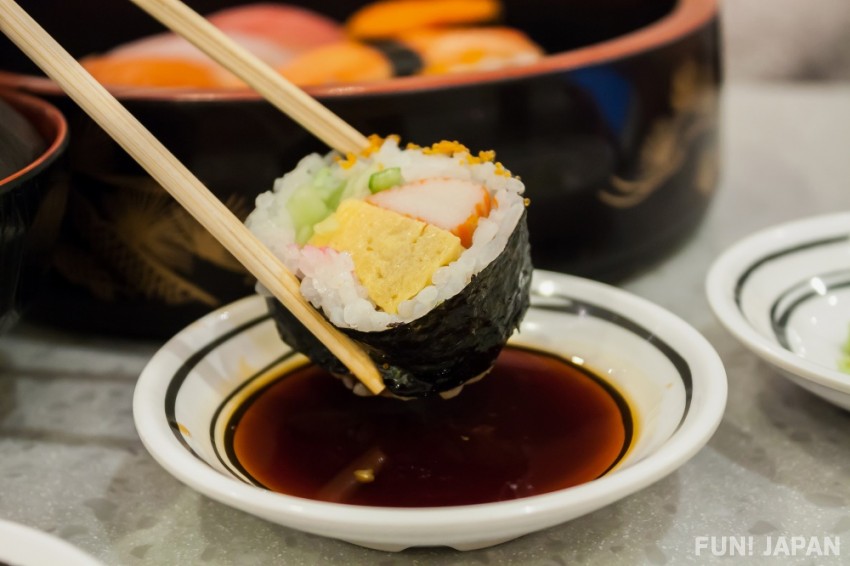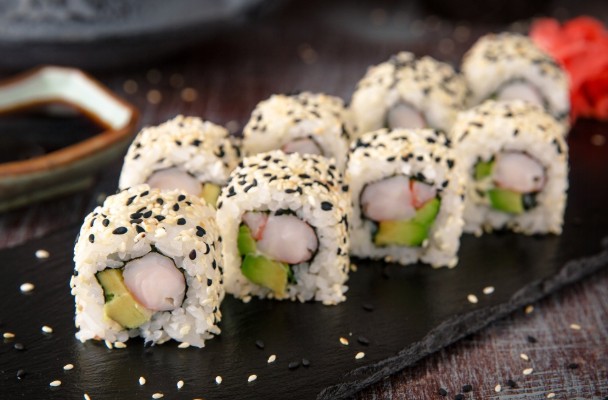
Sushi rolls are a simple combination of sushi rice and filling (fish or other) wrapped in nori and shaped into a stick like shape. Typically fresh fish is used for the filing but the filing can be raw, pickled, or cooked/seared ingredients as well. Even vegetables and omelette eggs are used as fillings as well. Let’s take a look at the different kinds of sushi rolls and their history.
Sushi Rolls: How did they come about?

Sushi rolls first came about in 18th century Japan, but back then it was not something made at home but was a type of sushi only available at sushi restaurants. In Edo (now known as Tokyo), it was common for thin rolls called hosomaki to be served (as seen in the left photo). These rolls were made with just one type of filling. In the Kansai region however, thick rolls called futomaki were common (as seen in the right photo), with these rolls having multiple types of fillings in a single roll.
Just like how making Inari sushi and gomoku sushi was common in households for not requiring fresh fish as ingredients, sushi rolls also slowly made their way into households.
Learn more about the history of sushi with the article link below:
→ https://www.fun-japan.jp/en/articles/6773
How to make Sushi Rolls

Have you ever seen a sushi chef prepare sushi rolls? Sushi rice is spread over nori, the dried seaweed. The ingredients are placed near the center and the entire thing is rolled up. Finally the roll is lightly pressed to solidify its shape. All this is done very quickly to prevent the heat from the chef’s hands from warming the ingredients and making it taste bad. Below are some simple steps, so why not give it a try?
- Step 1. Place the nori on the makisu (bamboo mat) in a wide position so that the short sides of the nori are facing the sides.
- Step 2. Spread the sushi rice evenly while leaving a space of about 2 cm above the nori and about 5 mm below it.
- Step 3. Just below the center of the sushi rice, place the ingredients in a line evenly.
- Step 4. From the front, lift the nori along with the base of the makisu and roll it up while gently holding down the ingredients.
- Step 5. Once rolled up, remove it from the mat and cut it into 2cm pieces. If you wipe your knife with a wet cloth before cutting it each time, it will make cleaner cuts.
Video tutorials are also available:
Salmon Roll Recipe
→ https://www.youtube.com/watch?v=2fv0veXlrtY
Learn how to make sushi rice from the article link below:
→ https://www.fun-japan.jp/en/articles/11688
How to Dip Sushi Rolls in Soy Sauce

When eating nigiri sushi, it is common to dip them in soy sauce. Sushi rolls are also commonly dipped in soy sauce before eating. One manner when doing so is to dip it and make sure no rice falls out and makes a mess in the soy sauce plate. You can dip the top or bottom of the rolls, but if you feel like it might make a mess, dipping the nori sides may be easier.
Learn more about how to eat sushi with the article link below:
→ https://www.fun-japan.jp/en/articles/11688
California Roll

You may be familiar with California rolls, which usually don’t use raw fish but often uses shrimp or crab, along with avocado and other vegetables for its filling. It is also unique that it is usually wrapped inside out, with the rice on the outside. The origin theories of the California Roll can vary, but it was actually first created by a Japanese chef. In 1963, the restaurant “Tokyo Kaikan” opened in Los Angeles, and the sushi chefs there devised to create a kind of sushi that would be appealing to Americans. Back then the idea of eating raw fish was still not common, so instead they used crab combined with the familiar taste of avocado and mayonnaise, making the sushi much more approachable to Americans during that time. It is also said the black nori being on the outside did not seem appealing to them, which is why the idea of rolling them inside out was used.

Comments